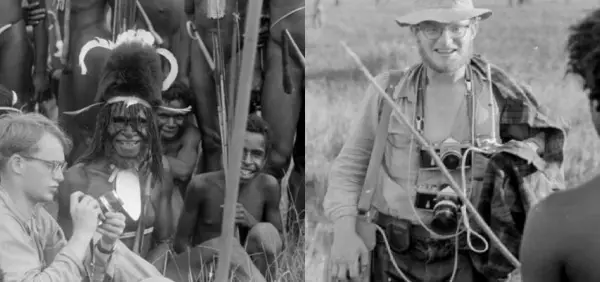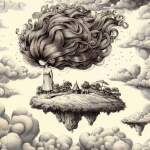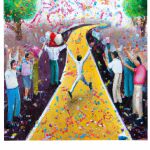The incredible story of the millionaire eaten by cannibals
The Mystery of Michael Rockefeller: The young photographer who left New York to live with cannibals and disappeared in the New Guinea jungle in 1961....
Table of Contents
- A Young Rockefeller Between the Jungle and Mystery
- The Journey and the Final Challenge
- An Unprecedented Search and an Uncomfortable Truth
- A Legend That Never Dies
Follow Patricia Alegsa on Pinterest!
A Young Rockefeller Between the Jungle and Mystery
Think about it: what would you do if you were born into luxury, with your path laid out by the Rockefeller name? Michael, however, chose the opposite route. At just 23 years old, he left the comfort of New York — that place where almost nothing seems impossible — to venture into the wild heart of New Guinea. He preferred a passion for photography and anthropology over investment funds and offices with spectacular views.
On his departure to the Asmat region, Michael was not only seeking primitive artifacts for the New York Museum of Primitive Art. He wanted to understand the mindset of an enigmatic culture, of people whose norms and beliefs had barely been touched by the Western world.
Collecting instruments, drums, carved spears, and bisj — those intriguing totemic figures — was just the tip of the iceberg. Who wouldn’t feel captivated by that exploratory impulse, even if it meant walking through muddy paths, listening to unknown languages, and encountering practices as uncommon as ritual cannibalism?
From my experience reporting extreme stories, I know how a journey can change you completely. You face fear, uncertainty, and wonder — like Michael, who passed through thirteen villages, negotiating with axes, hooks, and tobacco to earn the trust of the Asmat. Many don’t know, but the bisj, those pointed wooden sculptures, were raised to greet the spirits of ancestors and recall unsatisfied vendettas. Did you know that even today, bisj wood is studied as a symbol of resilience and collective memory?
The great dramatic turn came on November 18, 1961. Michael, anthropologist René Wassing, and two young Asmat men were in a small boat, at the mercy of the Betsj River. The engine failed, the catamaran capsized, and they floated for hours, threatened by danger: crocodiles, piranhas, hunger, and despair. Michael made a desperate decision that not even the best Hollywood script would dare invent. He tied two empty canisters to his body and swam toward the distant shore. No one ever saw him alive again.
Can you imagine the scale of the operation? Planes, helicopters, boats, and all the Rockefeller influence combed every inch of the delta. I have seen stories where mobilized resources are never enough against the weight of the unknown. In the end, nothing: no clues, no body, not even a reliable lead. The Dutch limited themselves to saying “drowning,” but the doubt never left.
This case became myth and rumor. Testimonies collected over decades, notes from missionaries, articles in National Geographic, and even accounts from those who sold the boat to Michael pointed to the same fear: the Otsjanep tribe.
The Journey and the Final Challenge
From my experience reporting extreme stories, I know how a journey can change you completely. You face fear, uncertainty, and wonder — like Michael, who passed through thirteen villages, negotiating with axes, hooks, and tobacco to earn the trust of the Asmat. Many don’t know, but the bisj, those pointed wooden sculptures, were raised to greet the spirits of ancestors and recall unsatisfied vendettas. Did you know that even today, bisj wood is studied as a symbol of resilience and collective memory?
The great dramatic turn came on November 18, 1961. Michael, anthropologist René Wassing, and two young Asmat men were in a small boat, at the mercy of the Betsj River. The engine failed, the catamaran capsized, and they floated for hours, threatened by danger: crocodiles, piranhas, hunger, and despair. Michael made a desperate decision that not even the best Hollywood script would dare invent. He tied two empty canisters to his body and swam toward the distant shore. No one ever saw him alive again.
An Unprecedented Search and an Uncomfortable Truth
Can you imagine the scale of the operation? Planes, helicopters, boats, and all the Rockefeller influence combed every inch of the delta. I have seen stories where mobilized resources are never enough against the weight of the unknown. In the end, nothing: no clues, no body, not even a reliable lead. The Dutch limited themselves to saying “drowning,” but the doubt never left.
This case became myth and rumor. Testimonies collected over decades, notes from missionaries, articles in National Geographic, and even accounts from those who sold the boat to Michael pointed to the same fear: the Otsjanep tribe.
The most disturbing version said that the inhabitants wanted to avenge old colonial abuses by killing the outsider and subjecting his remains to cannibal rituals. The macabre part: some claim they used his bones as weapons or tribal ornaments, as if Michael’s life had passed into another dimension in Asmat history.
His disappearance not only shocked his powerful family but also wove an unending legend. How many times does despair end up turning into myth? Michael’s diaries and the objects he managed to collect now rest in museums. He inspired novels, documentaries, and even songs, adding new layers of mystery to a case that was never fully solved.
Let me ask you: is it the mystery that obsesses us or the bravery of someone who dared to cross all limits? As a journalist, I am left with the bitter feeling that neither all the money nor influence are safe against the power of the unknown and the ancestral dignity of cultures that, in their own way, were also fighting for their place in the world. What other version of the events do you think could have existed? Did the myth surpass reality? The New Guinea jungle always keeps its secrets better than any other place.
A Legend That Never Dies
His disappearance not only shocked his powerful family but also wove an unending legend. How many times does despair end up turning into myth? Michael’s diaries and the objects he managed to collect now rest in museums. He inspired novels, documentaries, and even songs, adding new layers of mystery to a case that was never fully solved.
Let me ask you: is it the mystery that obsesses us or the bravery of someone who dared to cross all limits? As a journalist, I am left with the bitter feeling that neither all the money nor influence are safe against the power of the unknown and the ancestral dignity of cultures that, in their own way, were also fighting for their place in the world. What other version of the events do you think could have existed? Did the myth surpass reality? The New Guinea jungle always keeps its secrets better than any other place.
Subscribe to the free weekly horoscope
Aquarius Aries Cancer Capricorn Gemini Leo Libra Pisces Sagittarius Scorpio Taurus Virgo
-
 COVID: 7 million deaths in 5 years
COVID: 7 million deaths in 5 years
Five years of COVID! WHO reveals 7 million deaths and 776 million cases. Keep your vaccines up to date! -
 The fiction became reality! The real stalker from the Netflix series threatened the journalist with 30 messages
The fiction became reality! The real stalker from the Netflix series threatened the journalist with 30 messages
Incredible: after the conversation he had with the harassing woman, the journalist from the British newspaper reported being harassed with numerous threatening calls and voicemail messages. -
 Appearance of UFOs in various places in the US worries authorities
Appearance of UFOs in various places in the US worries authorities
Mystery in New Jersey! Unsettling drones cause airport closures. The mayor and residents demand federal answers. What is happening? -
 Former prime minister accused of murdering his wife: chilling video
Former prime minister accused of murdering his wife: chilling video
Former Prime Minister Kuandyk Bishimbayev is accused of beating his wife, Saltanat Nukenova, to death during an argument at a restaurant. Security camera footage has been released. -
 It's not a manipulated photograph! Green capybaras found in Argentina
It's not a manipulated photograph! Green capybaras found in Argentina
Green alert in Entre Ríos, Argentina! Hulk-style capybaras surprise in the city of Concordia. The bacteria dyed them in Lago Salto Grande. Do you take precautions?
I am Patricia Alegsa
I have been writing horoscope and self-help articles professionally for over 20 years.
Subscribe to the free weekly horoscope
Receive weekly in your email the horoscope and our new articles on love, family, work, dreams and more news. We do NOT send spam.
Astral and numerological analysis
-
 Discover your future, secret personality traits and how to improve in love, business and life in general
Discover your future, secret personality traits and how to improve in love, business and life in general
-
 Online Dream Interpreter: with artificial intelligence
Do you want to know what a dream you had means? Discover the power of understanding your dreams with our advanced online dream interpreter using artificial intelligence that responds to you in seconds.
Online Dream Interpreter: with artificial intelligence
Do you want to know what a dream you had means? Discover the power of understanding your dreams with our advanced online dream interpreter using artificial intelligence that responds to you in seconds.
-
 What the characters from the Friends series would look like at 5 years old
What the characters from the Friends series would look like at 5 years old
Artificial intelligence has been used to transform the iconic Friends characters into characters as young as 5 years old. -
 Strange discovery on Mars, a rock that surprises NASA
Strange discovery on Mars, a rock that surprises NASA
A strange finding on Mars: Perseverance discovers a rock with zebra markings, sparking the interest of scientists and new theories in the Jezero crater. -
 Supplements to Improve Memory in Older Adults
Supplements to Improve Memory in Older Adults
Study reveals that fiber supplements improve memory in older adults. Discover how to care for your brain with these surprising findings! -
 Tragedy: A Bodybuilder Dies Suddenly at Just 19 Years Old
Tragedy: A Bodybuilder Dies Suddenly at Just 19 Years Old
Tragedy in Bodybuilding: Matheus Pavlak, promising 19-year-old Brazilian bodybuilder, found dead in his apartment. Shock in the sport. -
 Extreme Phenomena: Fire Tornadoes and Climate Change
Extreme Phenomena: Fire Tornadoes and Climate Change
Extreme phenomena, increasingly frequent, intensify fires and affect climatology at both local and global levels. Learn about their impact! -
 Surprising health benefits of almonds
Surprising health benefits of almonds
Discover why almonds are a superfood: they improve cardiovascular health, aid digestion, and beautify the skin. Incorporate this nutritious nut! -
 Apocalypse Now: Controversies and Chaos in the Filming of the Movie
Apocalypse Now: Controversies and Chaos in the Filming of the Movie
Discover the chaotic filming of 'Apocalypse Now': Marlon Brando out of control, actors on edge, loose tigers, and Coppola's megalomania in a legendary shoot. -
 What does it mean to dream about angels?
What does it mean to dream about angels?
Discover the meaning of dreaming about angels and what this dream can reveal about your life. Read our article and find the answers you seek! -
 Extreme Allergy: A woman is allergic to everything, including her own husband
Extreme Allergy: A woman is allergic to everything, including her own husband
Discover the inspiring story of Johanna Watkins, who faces extreme allergies and a limited diet, while her husband Scott lovingly cares for her. -
 What does it mean to dream of a career?
What does it mean to dream of a career?
Discover the meaning behind your dreams with a race: are you running towards your goals or running away from your fears? Learn how to interpret this dream in our article! -
 Learn to love according to your zodiac sign
Learn to love according to your zodiac sign
Discover how to learn to love according to your Zodiac. Love can be complicated, but there are always lessons to be learned. Read on. -
 Scandalous fight at a Bad Bunny concert!
Scandalous fight at a Bad Bunny concert!
A scandalous fight broke out while singer Bad Bunny was performing live at one of his concerts in the United States. -
 What does it mean to dream of urine?
What does it mean to dream of urine?
Discover the fascinating world of dream interpretation with our article on What does it mean to dream of urine? Explore its meaning in different contexts and unravel the hidden messages of your subconscious.